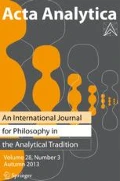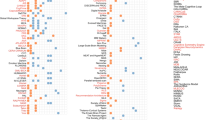Abstract
Intentionality is a mark of the mental, as Brentano (1874) noted. Any representation or conception of anything has the feature of intentionality, which informally put, is the feature of being about something that may or may not exist. Visual artworks are about something, whether something literal or abstract. The artwork is a mentalized physical object. Aesthetic experience of the artwork illustrates the nature of intentionality as we focus attention on the phenomenology of the sensory exemplar. This focus of attention on the exemplar in aesthetic experience simultaneously exhibits what the intentional object is like and what our conception of it is like. The exemplar is Janus-faced, looking in one direction outward toward the objects conceived and in the other direction inward toward our conceiving of them. It shows us what intentionality is like and how we know it.
Similar content being viewed by others
References
Brentano, F. (1874). Psychology from an empirical standpoint. O. Kraus (Ed.). English edition: L. L. McAlister (1973). A. C. Rancurello, D. B. Terrell & L. L. McAlister (trans.). London: Routledge and Kegan Paul.
Dretske, F. (1981). Knowledge and the flow of information. Cambridge: MIT Press.
Fodor, J. A. (1983). The modularity of mind. Cambridge: MIT Press.
Fürst, M. (2010). A dualist account of phenomenal concepts. in draft.
Goodman, N. (1968). Languages of art: An approach to a theory of symbols. Indianapolis: Bobbs-Merrill.
Hume, D. (1739). A treatise of human nature. London: John Noon.
Ismael, J. (2007). The situated mind. New York and Oxford: Oxford University Press.
Jackson, F. (1982). Epiphenomenal qualia. Philosophical Quarterly, 32, 127–36.
Kriegel, U. (2004). Moore's paradox and the structure of conscious belief. Erkenntnis, 61, 99–121.
Lewis, D. (1988). What experience teaches. Proceedings of the Russellian Society, 13, 29–57.
Lehrer, K. (1996). Skepticism, lucid content and the metamental loop. In A. Clark et al. (Eds.), Philosophy and cognitive science (pp. 73–93). Boston: Kluwer Academic Publishers.
Lehrer, K. (1996a). Consciousness. In Alfred Schramm (Ed.), Philosophie in Österreich (pp. 20–32). Vienna: Hölder-Pichler-Tempsky.
Lehrer, K. (2006). Consciousness, representation and knowledge. In Uriah Kriegel & Kenneth Williford (Eds.), Self-representational approaches to consciousness (pp. 409–420). Cambridge: MIT Press.
Papineau, D. (2002). Thinking about Consciousness. Oxford: Oxford University Press.
Papineau, D. (2007). Phenomenal and perceptual concepts. In Torin Alter & Sven Walter (Eds.), Phenomenal concepts and phenomenal knowledge (pp. 111–145). Oxford: Oxford University Press.
Reid, T. (1785). Essays on the intellectual powers of man. Edinburgh: Bell.
Spencer-Brown, G. (1969). Laws of form. London: Allen and Unwin.
Tye, M. (2005). On the nonconceptual content of experience. In M. E. Reicher & J. C. Marek (Eds.), Experience and analysis (pp. 221–239). Vienna: Öbv & Hpt.
Wittgenstein, L. (1922). Tractatus Logico-Philosophicus. C.K. Ogden (trans.). London: Routledge and Kegan Paul.
Author information
Authors and Affiliations
Corresponding author
Rights and permissions
About this article
Cite this article
Lehrer, K. What Intentionality Is Like. Acta Anal 26, 3–14 (2011). https://doi.org/10.1007/s12136-010-0116-7
Received:
Accepted:
Published:
Issue Date:
DOI: https://doi.org/10.1007/s12136-010-0116-7



